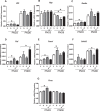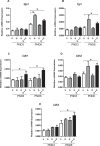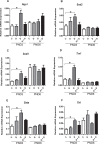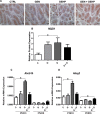In utero exposure to di-(2-ethylhexyl) phthalate induces testicular effects in neonatal rats that are antagonized by genistein cotreatment
- PMID: 26316063
- PMCID: PMC4711908
- DOI: 10.1095/biolreprod.115.129098
In utero exposure to di-(2-ethylhexyl) phthalate induces testicular effects in neonatal rats that are antagonized by genistein cotreatment
Abstract
Fetal exposure to endocrine disruptors (EDs) is believed to predispose males to reproductive abnormalities. Although males are exposed to combinations of chemicals, few studies have evaluated the effects of ED mixtures at environmentally relevant doses. Our previous work showed that fetal exposure to a mixture of the phytoestrogen genistein (GEN) and the plasticizer di-(2-ethylhexyl) phthalate (DEHP) induced unique alterations in adult testis. In this follow-up study, we examined Postnatal Day 3 (PND3) and PND6 male offspring exposed from Gestational Day 14 to parturition to corn oil, 10mg/kg GEN, DEHP, or their combination, to gain insight into the early molecular events driving long-term alterations. DEHP stimulated the mRNA and protein expression of the steroidogenic enzyme HSD3B, uniquely at PND3. DEHP also increased the mRNA expression of Nestin, a Leydig progenitor/Sertoli cell marker, and markers of Sertoli cell (Wt1), gonocyte (Plzf, Foxo1), and proliferation (Pcna) at PND3, while these genes were unchanged by the mixture. Redox (Nqo1, Sod2, Sod3, Trx, Gst, Cat) and xenobiotic transporter (Abcb1b, Abcg2) gene expression was also increased by DEHP at PND3, while attenuated when combined with GEN, suggesting the involvement of cellular stress in short-term DEHP effects and a protective effect of GEN. The direct effects of GEN and mono-(2-ethylhexyl) phthalate, the principal bioactive metabolite of DEHP, on testis were investigated in PND3 organ cultures, showing a stimulatory effect of 10 μM mono-(2-ethylhexyl) phthalate on basal testosterone production that was normalized by GEN. These effects contrasted with previous reports of androgen suppression and decreased gene expression in perinatal rat testis by high DEHP doses, implying that neonatal effects are not predictive of adult effects. We propose that GEN, through an antioxidant action, normalizes reactive oxygen species-induced neonatal effects of DEHP. The notion that these EDs do not follow classical dose-response effects and involve different mechanisms of toxicity from perinatal ages to adulthood highlights the importance of assessing impacts across a range of doses and ages.
Keywords: Leydig; ROS; Sertoli; endocrine disruptor; gene expression; genistein; germ cells; gonadal function; mixture; phthalate; rodents (mice, guinea pigs, rats, voles); testis; toxicology.
© 2015 by the Society for the Study of Reproduction, Inc.
Figures







Similar articles
-
Disruption of rat testis development following combined in utero exposure to the phytoestrogen genistein and antiandrogenic plasticizer di-(2-ethylhexyl) phthalate.Biol Reprod. 2014 Sep;91(3):64. doi: 10.1095/biolreprod.114.120907. Epub 2014 Jul 16. Biol Reprod. 2014. PMID: 25031359
-
In utero exposure to low doses of genistein and di-(2-ethylhexyl) phthalate (DEHP) alters innate immune cells in neonatal and adult rat testes.Andrology. 2020 Jul;8(4):943-964. doi: 10.1111/andr.12840. Epub 2020 Jul 3. Andrology. 2020. PMID: 32533902
-
In utero exposure to di-(2-ethylhexyl) phthalate exerts both short-term and long-lasting suppressive effects on testosterone production in the rat.Biol Reprod. 2008 Jun;78(6):1018-28. doi: 10.1095/biolreprod.107.065649. Epub 2008 Mar 5. Biol Reprod. 2008. PMID: 18322279
-
Fetal origin of endocrine dysfunction in the adult: the phthalate model.J Steroid Biochem Mol Biol. 2013 Sep;137:5-17. doi: 10.1016/j.jsbmb.2013.01.007. Epub 2013 Jan 17. J Steroid Biochem Mol Biol. 2013. PMID: 23333934 Review.
-
Changes in MAPK pathway in neonatal and adult testis following fetal estrogen exposure and effects on rat testicular cells.Microsc Res Tech. 2009 Nov;72(11):773-86. doi: 10.1002/jemt.20756. Microsc Res Tech. 2009. PMID: 19565636 Review.
Cited by
-
Genistein attenuates di‑(2‑ethylhexyl) phthalate-induced testicular injuries via activation of Nrf2/HO‑1 following prepubertal exposure.Int J Mol Med. 2018 Mar;41(3):1437-1446. doi: 10.3892/ijmm.2018.3371. Epub 2018 Jan 9. Int J Mol Med. 2018. PMID: 29328408 Free PMC article.
-
Systematic reviews and meta-analyses of human and animal evidence of prenatal diethylhexyl phthalate exposure and changes in male anogenital distance.J Toxicol Environ Health B Crit Rev. 2018;21(4):207-226. doi: 10.1080/10937404.2018.1505354. Epub 2018 Sep 10. J Toxicol Environ Health B Crit Rev. 2018. PMID: 30199328 Free PMC article.
-
Independent and combined effects of diethylhexyl phthalate and polychlorinated biphenyl 153 on sperm quality in the human and dog.Sci Rep. 2019 Mar 4;9(1):3409. doi: 10.1038/s41598-019-39913-9. Sci Rep. 2019. PMID: 30833626 Free PMC article.
-
Reproductive toxicology: keeping up with our changing world.Front Toxicol. 2024 Oct 11;6:1456687. doi: 10.3389/ftox.2024.1456687. eCollection 2024. Front Toxicol. 2024. PMID: 39463893 Free PMC article.
-
Impact of Fetal Exposure to Endocrine Disrupting Chemical Mixtures on FOXA3 Gene and Protein Expression in Adult Rat Testes.Int J Mol Sci. 2023 Jan 7;24(2):1211. doi: 10.3390/ijms24021211. Int J Mol Sci. 2023. PMID: 36674726 Free PMC article.
References
-
- de Boo HA, Harding JE. The developmental origins of adult disease (Barker) hypothesis. Aust N Z J Obstet Gynaecol. 2006;46:4–14. - PubMed
-
- Barker DJ, Osmond C. Infant mortality, childhood nutrition, and ischaemic heart disease in England and Wales. Lancet. 1986;1:1077–1081. - PubMed
-
- Toppari J, Virtanen HE, Main KM, Skakkebaek NE. Cryptorchidism and hypospadias as a sign of testicular dysgenesis syndrome (TDS): environmental connection. Birth Defects Res a Clin Mol Teratol. 2010;88:910–919. - PubMed
Publication types
MeSH terms
Substances
Grants and funding
LinkOut - more resources
Full Text Sources
Other Literature Sources
Molecular Biology Databases
Research Materials
Miscellaneous

